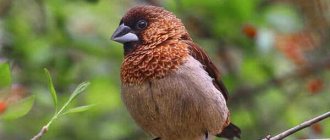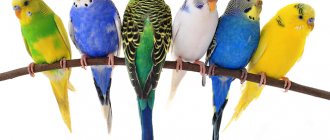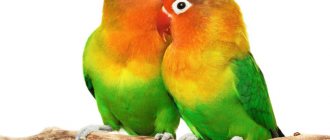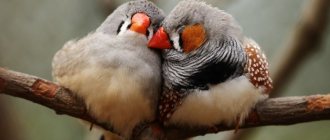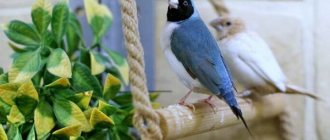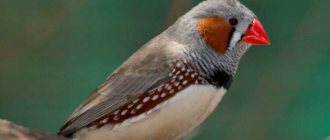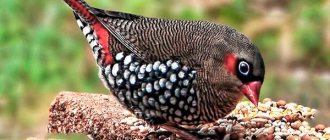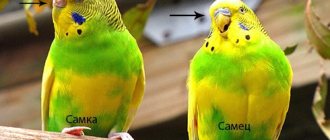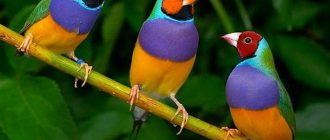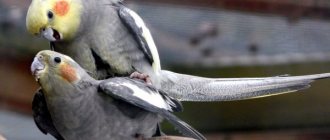Appearance of white finches
What do finches ? The description of this little bird must begin by mentioning its gullibility. An active and resilient creature is capable of winning the hearts of even the most indifferent to feathered people. In the wild, finches live in Australia and Africa. Some varieties are also found in South Asia. Birds live not only in thickets, but also in open areas.
Snow-white finches are small in size, their body length ranges from 10 to fifteen cm. Although they are equated with singing birds, they sing very poorly. Naturally, they are capable of starting a melodic trill, but it will look more like a whistle, buzzing or chirping. At the same time, males sing much better than females.
The finches' beak is arched, thick and curved, creating the impression that it is translucent, as if made of wax. In young birds it is dark in color, in males it is a bright coral color, and in females it is orange.
Amadins come in a variety of colors, sometimes their plumage is very beautiful and colorful.
Habitat[edit | edit code]
The distribution area of Gouldian finches includes, among others, the Kimberley region, which is limited to the west by the Indian Ocean, to the north by the Timor Sea, to the south by the Great Sandy Desert and the Tanami Desert. This Kimberley district (where Gouldian finches are still relatively common compared to other regions) is the hottest area in the entire southern hemisphere. Daytime temperatures here reach 40 and 45 °C in the shade. At night the temperature rarely drops below 35 °C. From November to April there is very heavy rain. Air humidity at this time ranges from 80 to 90%.
Gouldian finches are adapted to these extreme climatic conditions. They are very active at temperatures ranging from 30 to 45 °C, taking long periods of sunbathing. Other bird species, on the other hand, take refuge in the shade at these temperatures. In the Northern Territories, birds also prefer seasons when both high daytime temperatures and high humidity prevail. At this time, they look for semi-ripe seeds and insects that belong to their diet.
How to distinguish a female from a male
Since finches are birds that live in flocks in the wild, they are also not recommended to be kept alone at home. They definitely need relatives for communication, games, and fun. In addition, if the owner is unable to talk with the feathered pet for a long time, the lonely bird may become bored, which will certainly have a negative impact on its health.
Do you understand? The modern French painter Celeste Boursier-Mougenot made a project in which he recorded the sounds of finches made when walking on the strings of an electric guitar. Such a “concert” with 40 zebra finches was presented in famous galleries in London, Paris and Linz. The French also attempted a drum concert, but it failed.
Variants of sex differences in zebra finches of different colors.
If you are going to listen to the advice and get several finches, but do not plan to breed them at the same time, you need to purchase same-sex individuals. And to do this, you should already find out when purchasing where the girls are and where the boys are. If you purchase chicks specifically for the purpose of breeding, then you should protect yourself from a nasty surprise and a long wait for offspring when you suddenly acquire same-sex individuals. Therefore, the ability to distinguish between genders in this case will help you not make a mistake when choosing.
You should not blindly trust traders who will claim that they know exactly the sex of the bird. It is better to use the “trust, but verify” principle and, without the help of others, make sure that the person who is selling the birds for you is right.
Familiarize yourself with all the features of keeping and breeding finches at home.
to distinguish who is in front of you - a female or a male . In some species, color helps to understand this, which is usually more striking in males. In other cases, both the girl and the boy may look completely identical, and then it will be necessary to listen to their voices.
Singing
In those species in which sexual dimorphism is not expressed in plumage color, sex is determined by the sounds produced. Typically, males sing longer and more attractively. They perform more complex compositions. But the females either remain silent most of the time, or make fragmentary quiet sounds. It’s hard to call it singing.
You can hear the voice of birds starting from 4–5 months of age. The same age is recommended for purchasing finches.
Like the finch, the budgerigar is also a songbird. Find out more about the singing of budgerigars.
The size and color of the beak can also be used to determine the sex of the bird. So, in zebra finches, the boy’s beak is colored a richer reddish color, while the girl’s beak is diluted with orange. Typically this organ is larger in males. Another difference is the hump at the base of the beak, which is characteristic of males of certain species.
Which finches are most common?
There are about 38 species of finches and about 300 subspecies in the world, which mainly differ in the color of their plumage. We will introduce you to the more popular ones.
Do you understand? Amadina became the second bird whose brain was studied by scientists who tried to figure out how a melody is born in it. As a result of research work, it was revealed that the highest singing center and the nucleus of the acropallium are responsible for singing. If they are deactivated, the bird will no longer be able to trill.
Notes[edit | edit code]
- ↑ Boehme R.L., Flint V.E. Five-language dictionary of animal names. Birds. Latin, Russian, English, German, French / Under general. ed. acad. V. E. Sokolova. - M.: Russian language, RUSSO, 1994. - P. 440. - 2030 copies. — ISBN 5-200-00643-0.
- ↑ 1 2 Red Mark, 2013, p. 36.
- ↑ Konstantin Bolotov. . Colored birds confirmed the animal's fear of red. membrana (August 4, 2009). Access date: April 8, 2012.
- ↑ Sarah R. Pryke, Simon C. Griffith. . Genetic Incompatibility Drives Sex Allocation and Maternal Investment in a Polymorphic Finch. Science (20 March 2009). doi:10.1126/science.1168928. Access date: April 8, 2012. Archived June 19, 2012.
Temperature and light conditions
Because Japanese finches are an artificially bred species, they are not very capricious in terms of temperature. When they get into the apartment of their new owners, they perfectly tolerate the temperature and humidity of the room, which their owners like.
Do not overcool! Naturally, sudden changes in both should not be allowed. For example, you cannot ventilate a room for a long time in winter until the temperature becomes the same as on the other side of the window.
The light day will also suit the one you have, but you will need to turn on the lamp next to it.
By singing
It is enough to simply find the sex of adult finches by the sounds they make. After reaching the age of 4-6 months, males begin to sing, performing sonorous, long and complex trills. The voice of females is quieter, they are mostly silent and at times make short, abrupt sounds.
Crested and not so
Among the Japanese, you can often see crested and “curly” birds with small curls or cowlicks on certain parts of the body: in most cases on the head, neck or neck. Information about one hundred percent curly-haired birds (like curly-haired breeds of pigeons) “walks” on the Internet on various foreign-language websites, but its reliability and data on the genetics of such birds are very unclear.
Literature[edit | edit code]
- Red mark // Geo. - 2013. - No. 03(180). — P. 36.
- Horst Bielfeld. Das Prachtfinkenbuch - Sämtliche Arten, ihre Haltung, Pflege und Zucht. - Stuttgart: Eugen Ulmer Verlag, 1996. - ISBN 3-8001-7327-1.
- Horst Bielfeld. Gouldamadinen - Haltung, Zucht und Farbspielarten. - Stuttgart: Eugen Ulmer Verlag, 1985. - ISBN 3-8001-7364-6.
- Jürgen Nicolai (Hrsg), Joachim Steinbacher (Hrsg), Renate van den Elzen, Gerhard Hofmann. 'Prachtfinken - Australien, Ozeanien, Südostasien. - Stuttgart: Eugen Ulmer Verlag, 2001. - ISBN 978-3-8001-3249-4.
- Peter Clement, Alan Harris, John Davis. Finches and Sparrows - An Identification Guide. - London: Christopher Helm, 1993. - ISBN 0-7136-8017-2.
Features of gender determination
In many birds, including finches, sexual dimorphism in anatomical characteristics is very poorly developed. This circumstance can explain the difficulty of determining their gender at first glance or even upon detailed examination. This is especially difficult for beginners in the business of breeding birds, and even in cases where there is nothing to compare with (for example, the seller has only one bird or they are all the same in appearance). But you shouldn’t rush, much less trust the seller’s assurances about the sex of the birds, since there are some ways to determine the sex of finches that will help you solve this problem yourself. You can determine:
- by appearance (sizes of different-sex individuals within the same variety, color of plumage and beak, beak size);
- by voice data;
- by behavior.
Each of the above methods of distinguishing a boy from a girl among finches requires a more detailed consideration.
Male bronze-winged finches have black on their heads and tails, which are more abundant than females. Boys have green stripes with a bronze coating on their sides. In girls, the stripes are barely noticeable and blurred. In general, their coloring is duller than that of boys.
Amadins how to distinguish a male from a female?
Outside the mating season, the behavior of male and female finches is almost the same. Sex can only be determined by this characteristic during the nesting season. At this time the male sings, performs a courtship dance, and courts the female. The female responds to courtship by dancing and making quiet chirps, and also builds a nest. If there are two males in a cage, they will begin to chase each other, fight and fight for territory and food.
The easiest way to determine the sex of finches is by appearance: color, size, body proportions, structural features of the beak. In species without sexual dimorphism, boys can be distinguished from girls by their characteristic behavior, as well as by their voice.
By the beak
The shape, size and color of the beak of female and male finches have clearly visible differences. In males, the beaks are larger, more powerful, and more intensely colored, often with a predominance of red hues. Some species have a hump at the base of the beak. Females have more elegant and thin beaks of yellowish tints.
By behavior
Differences in the behavior of birds are more noticeable during the nesting period for the purpose of breeding offspring. Females are more actively involved in building the nest than the other half of the bird family. But at this time the male can show himself as a singer. It is difficult to distinguish a female from a male by behavior outside the mating season. These birds are quite active, nimble and curious, regardless of gender.
If there are 2 males in the cage, then there is a chance to “expose” them, since they will definitely conflict over various little things: when feeding, for the right to take the best place on the perch. And vice versa, 2 females will live amicably, there will be no collisions between them. But the latter, unfortunately, can also mean that you have both a female and a male in the cage. They will reveal themselves later. For breeding, it is better to buy a heterosexual pair or several birds, among which there will be only 1 male.
For more information on how to determine the sex of zebra finches, see the video below.
How to determine the sex of a finch bird
Selection of a pair is an important stage in breeding finches. Beginning poultry keepers often encounter difficulties in determining the sex of their pets, since in some species sexual dimorphism is weakly expressed or completely absent. However, distinguish a male finch from a female not only by appearance. There are several methods tested by experienced poultry farmers that allow you to accurately determine the sex of a bird.
By singing
It is quite easy to determine the sex of adult finches by the sounds they make. After reaching the age of 4-6 months, males begin to sing, performing loud, long and complex trills. The voice of females is quieter, they are mostly silent and from time to time they make short, abrupt sounds.
By the beak
The shape, size and color of the beak of female and male finches have clearly visible differences. In males, the beaks are larger, more powerful, and more intensely colored, often with a predominance of red hues. Some species have a hump at the base of the beak. Females have more elegant and thin beaks of yellowish tints.
Sexual differences in zebra finches
Female zebra finches differ from males in the color of their plumage. Both girls and boys with naturally wild colored feathers have ash-gray primary color.
Males have a brown and white patch on each cheek, separated by a vertical black stripe running straight from the eye. Also on the front of the neck, in the chest area, males have a “zebra” pattern consisting of light and black stripes.
The sides of the male’s body are brown, with white spots scattered in a chaotic manner. The belly is light beige, the beak is deep red, with a barely noticeable orange tint.
Females have neither a striped pattern on the chest and throat, nor a brown tint on the sides. On each cheek there is only a vertical black stripe with a small white spot. The belly has a yellowish tint. The beak is not as bright as that of the male - the red color is well diluted with an orange tint.
Several color mutations of zebra finches have been bred in captivity. White females and males of this species can only be distinguished by the color of their beaks. For boys it is deep red, for girls it is less bright. Females of the brown mutation have a white belly with a brown tint. In males it is white or white-gray.
Males of the cream mutation have light yellow spots on their cheeks, sometimes with an orange sheen. The sides are yellow-brown. Cream female zebras do not have orange or yellow tones in their coloring.
Males of the penguin mutation have orange cheek patches and tan flanks with white spots. Female “penguins” have completely white cheeks and a noticeably darker head.
– Japanese finches are very easy to keep and are perfect for beginner bird lovers. As a favorite pet, the seagull can even be recommended for children of middle school age and older. – Japanese finches do not make noise, do not emit any odors (if, of course, you take care of the cleanliness in the cage in a timely manner), do not cost a lot of money, feeding and maintaining them will not hit your wallet; In addition, they are healthy, stress-resistant and live long.
Methods for determining gender
The easiest way to determine the sex of finches is by appearance: color, size, body proportions, structural features of the beak. In species without sexual dimorphism, boys can be distinguished
Determining the sex of some species of finches can be difficult, especially when there is no difference in appearance between males and females. In order to choose the right pair, you should rely on a set of signs that allow you to make a conclusion about the sex of the birds. When determining sex in species that do not have pronounced sexual dimorphism, one should rely primarily on the behavior of birds and the sounds they make. However, these methods are only suitable for individuals who have reached sexual maturity; in this case, it is not possible to determine the sex of young animals.
If you liked the article or have something to add, then leave your comments and also join our VKontakte group.
By voice
Experts consider singing to be the most accurate sign in determining the sex of a finch. Only the male of this species of songbird can produce the longest and most complex sounds . True, it should be noted that in some varieties of finches, neither males nor females have the ability to sing, but this circumstance can be considered an exception. Female finches can only produce short sounds, often reminiscent of the sound of some electronic alarm clocks with an abrupt “peep-peep” sound. But the volume of bird sounds is much quieter.
The method of determining sex by voice has a significant drawback - birds begin to sing at the age of 4 to 6 months, not earlier.
By the way, it is at this age that you need to look for a pet finch. In addition, males can also “peep”. And on command they are unlikely to burst into trills, so it is often not possible to check its vocal abilities when purchasing a pet.
Features of birds
Amadins have a thick beak, curved in an arc, and dense plumage. The color can be any - they are mostly motley, bright birds, with contrasting shades of feathers. Females have a more faded color, just like young animals, males are more striking. There are crested representatives. The breed belongs to the family of weaver finches.
The size of the birds is small, and the colors of the Japanese can be different:
- brown top;
- the rest of the body is grayish or snow-white;
- there are representatives of monochrome color - reddish, white, yellow;
- Considering several hundred years of breeding, the Japanese have quite a few varieties that differ in different combinations of shades;
- Spotted-type asymmetry of color can often be observed.
The bird's beak has an original shape and color: black and blue at the top, light at the bottom. The colors of the Japanese are indistinguishable by gender, but the singing differs.
This breed is very easy-going and undemanding in care; in addition, it perfectly feeds weaver chicks if necessary.
- loves the company of birds;
- calm, unpugnacious disposition;
- gets along well with its own kind in the same cage;
- During the nesting period, it is necessary to separate birds into pairs.
White Japanese are weaker by nature, have fragile health, less fertility, grow more slowly, and often have physical disabilities.
In the 20th century, a crested variety of Japanese was developed. Tufts can vary in color and shape:
- bunch-shaped;
- lush-thick;
- double type.
And more recently, curly-haired Japanese were bred. They have curled plumage in the chest, back, and shoulders.
Growing conditions
When you bring the bird home, give it some time to get used to it. Do not put in a common cage, as quarantine is necessary. At first, the finch is kept separately to identify health problems, so that the sick bird cannot infect others.
In the first days, the finch's appetite, behavior, and stool are assessed. Ideally, feces are submitted for analysis. After a month, if no suspicious signs are detected, you can place the bird with your neighbors.
Amadins should not be removed from the cage unless absolutely necessary. They become seriously frightened, and careless movement can lead to the death of the bird. It is better to move birds from one enclosure to another, catching birds with a net in the dark. Adaptation of the Japanese proceeds quite smoothly, calmly, if the conditions of detention are met: the birds are warm, dry, well fed and sheltered from drafts. Birds can be kept in cages or aviaries.
- a very convenient option for apartments;
- can be metal, wood, combined;
- the optimal location of the door is just below the perches, so that the bird does not accidentally fly out when serving food or drink;
- it is necessary to equip it with a pull-out type tray;
- the size is chosen based on the number of birds and their size;
- the height of the cage should be greater than the width;
- round, diamond and trapezoidal checkers are not suitable for this breed;
- You should not purchase cages with decor such as balconies, windows, towers.
- the best option for keeping birds;
- size and shape may vary;
- in this room the conditions for birds are close to natural;
- in enclosures, finches grow healthier;
- installed in a bright corner of the room;
- it is necessary to equip it with wooden frames and cover it with boards;
- the size of the doors should allow a person to easily enter inside;
- The occupancy rate must not be exceeded.
Proper care
The Japanese are a rather peaceful, non-timid breed, and the cage can be safely placed at any height. Approaching the cage will not affect the bird's mood in any way. Cages should not be placed near heating devices; if the room is heated by a stove or fireplace, do not place the cage under the ceiling.
It is very important to keep birds clean:
- Dampness and dirt are very harmful to finches;
- it is necessary to clean the cage or enclosure at least every other day;
- dirt from the poles is cleaned with a knife, then they are treated with boiling water;
- containers for water and food are washed every day with soap and hot water and wiped dry;
- in hot weather, the water changes frequently;
- Do not place water and drinking containers nearby, and do not place them under the perches.
Finches love water and enjoy swimming. Therefore, you need to periodically give them this opportunity by hanging a bathtub with a small amount of water at room temperature in the cage. Water treatments have a good effect on the health of birds and the condition of their feathers. For birds of this breed, sunlight is important; lack of lighting should not be allowed. Otherwise, the birds' metabolism may be disrupted and a number of diseases may arise. In summer, you need to put the cage outside for about 40 minutes a day.
This breed does not like cold and dampness. The room temperature should not be lower than 15°C, the optimal range is from 15 to 25°C.
Overheating is just as dangerous for birds as cold.
The room for keeping finches must have the following equipment:
- feeders;
- sippy cups;
- mineral type feed jar;
- nesting device;
- perches.
The best feeders and drinkers are glass, plastic, porcelain. It is better to avoid products made from clay, copper, and wood - they are less hygienic. The poles are made from soft wood, suitable for:
- Linden;
- aspen;
- willow;
- elder.
The bottom of the cage or the floor of the enclosure is covered with bedding from:
- sand;
- sawdust;
- shavings;
- paper
Content
Among lovers of feathered friends, finches are in great demand. After all, if there were a “Miss Beauty” competition among indoor birds, then this type of exotic bird would definitely be in the top three. They not only fascinate with their beauty, but many of them also sing well, and besides this, they are easy to care for and maintain. The main thing is to invest your soul and love, because finches really feel this.
Contents in the apartment
If you buy a zebra finch in an enclosure where there are two or more of them, we recommend taking two birds at once. After all, they become very attached to each other and then can suffer greatly. Therefore, immediately check with the seller about their preferences, so that later there is no “lamour-tuzhur”.
- A cage must be selected with a size of 300*200*250 mm, preferably with a lower pull-out tray. This is not some kind of whim, just this little nuance will make cleaning much easier.
- The cage is cleaned regularly several times a week. There are cases when finches attack the owner’s hand, trying to bite it when he is cleaning up their territory. This is normal for the behavior of finches. Although the bird is small, it has character.
- The cage must be placed in the brightest room, because they are light-loving, and in winter it is advisable to place them near an artificial light source, otherwise zebra finches are lethargic and inactive.
- Keep the cage away from drafts and sudden changes in temperature ; it should be constant and fluctuate around 18–20 degrees. Also keep away from noise and sharp sounds - this can lead to instant death .
- In your pets' house you need to place two perches, two drinking bowls, a feeder and a bath. This type of bird is ambitious and they enjoy water procedures.
- Nutrition should be balanced and rich in vitamins. They can live independently in their cage without the presence of their owners for about 5 days, as long as they have enough food and drink.
Care
Honestly, caring for finches does not take much time and does not take much effort, but if you are a lazy person, then finches are not for you. They love cleanliness and will not tolerate dirt either in their cages or around them.
- The cage must be cleaned regularly. All finches love spacious cages. Poultry farmers recommend choosing rectangular ones, because in square ones they feel uncomfortable, but in round ones they generally experience fear and even experience stress. And get a flat-top living space for your pets.
- Cover the bottom with dry sand about two centimeters, and do not forget to change it. The cage must be placed in a bright room, and keep in mind that the birds need to be in direct sunlight for at least three hours a day; the more they sunbathe, the better.
- Keep away from drafts - birds, like people, do not like them. But also remember about a balanced and fortified diet. You can read all this on forums where various topics related to finches are discussed. And most bird farmers note that these birds are the friendliest, most beautiful, and active. Among the shortcomings, a dispute has flared up - some write that their singing is annoying, others say the opposite.
Nutrition
Nutrition for finches plays a very important role: in freedom, birds live 3–5 years, and in captivity up to 10.
Mixtures:
- grain mixtures;
- millet (considered the healthiest);
- buckwheat;
- millet;
- corn chaff;
- wheat chaff;
- sunflower seeds.
Soft food (for vitamin deficiency and diseases from poor nutrition):
- eggs;
- low-fat cottage cheese;
- boiled rice.
Mineral feeding:
- sand;
- pebbles;
- shell rock;
- eggshell.
Water:
- filtered water;
- boiled water.
Forbidden:
- dill;
- onion.
They eat grain mixtures, low-fat cottage cheese, chicken eggs and wheat bread. You can purchase dry, green, cereal food at a pet store. In addition to food, adult birds must be given calcium, fruits and greens, and chicks must be given cereals and eggs.
Vegetable diet
- zucchini - rich in mineral salts. There are large quantities of potassium, phosphorus, magnesium, and calcium salts. Zucchini contains various vitamins - A, E, C, B1, B2, nicotinic acid. The most common organic acid in zucchini is malic acid. Zucchini is also rich in folic acid, which plays an important role in the process of hematopoiesis. You can offer zucchini either cut into slices or as part of a mash, grated and mixed with other ingredients, for example, grated egg, carrots, cucumber. Also, the zucchini can be grated, mixed only with grated breadcrumbs and served in a small bowl in this form.;
- Chinese cabbage - contains minerals and vitamins in the same quantities as the well-known white cabbage. However, there is 2 times more vitamin C in Beijing cabbage than in regular cabbage and in head lettuce, as well as protein. Chinese cabbage also contains vitamins A, C, B1, B2, B6, PP, E, P, K, U, 16 types of amino acids, glucose and organic acids. The juice of this cabbage is rich in vitamins such as B1, B2, B12, PP. Finches and astrildas very readily eat the leaves of Chinese cabbage. They can be secured in a vegetable holder or between the bars of a cage.;
- broccoli - has a high content of vitamins - A, C, E, K, as well as PP and group B; minerals - potassium, calcium, iron, sodium, phosphorus, magnesium, chromium, manganese, iodine, copper, boron; carbohydrates and proteins; There is also carotene. Finches can be given broccoli, finely chopped into a mash, mixed with other ingredients, for example, grated egg and carrots.;
- carrots - amadins are very beneficial for health due to their high content of vitamins - A, B1, B2, B3, B6, C, E, K, PP, mineral salts of potassium, iron, copper, iodine, phosphorus, enzymes, fructose and glucose, carotene. Carrots are perhaps the main vegetable that is often included in the diet of birds. Amadins can be given grated as part of mash (with grated egg, zucchini), or simply mixed with grated breadcrumbs.;
- sweet red pepper - contains vitamins A, C, B, B1, B2, B6, PP, P, E, K, folic acid, organic acids and mineral salts, as well as carbohydrates, starch, fiber and pectin. Sweet bell peppers can be given in small pieces, secured in a special holder for vegetables and fruits.;
- cucumbers - also contain vitamins (in small quantities) and microelements. Cucumber fruits are 95 percent water, but otherwise contain vitamins: A, B1, B2 PP, C, carotene, pectin, calcium, magnesium, iron, silicon, phosphorus, sulfur, iodine and fiber. Cucumber can be given to finches by cutting them into slices and securing them in a special vegetable holder. Also, it can be included in mash by grating and mixing with other ingredients, for example, egg, carrots, zucchini.;
- Beetroot is unique in its content of nutrients. It contains: protein, fat, sugar, fiber, organic acids, mineral salts, microelements (magnesium, potassium, calcium, iron, sodium, chlorine, etc.); vitamins - C, B1, B2, P, PP and folic acid. Beets occupy one of the first places among vegetables in terms of iodine content. Finches and astrilds can grate beets, squeeze them thoroughly and mix with grated breadcrumbs.;
- pumpkin - contains carotene (provitamin A), vitamins A, B1, B2, B6, C, D, PP, E. It also contains a rather rare vitamin T, many acids, including nicotinic acid, and salts of various microelements. Pumpkin can be given to finches either in slices, secured in a vegetable holder, or as part of mash, grated and mixed with other ingredients, for example, egg, zucchini.;
- squash - rich in vitamins such as PP, B1, B2, C. Also, this vegetable is rich in macro and microelements: calcium, magnesium, sodium, potassium, phosphorus, iron. Amadins can be offered squash either cut into slices or as part of a mash, grated and mixed with other ingredients, for example, grated egg, carrots.;
- Brussels sprouts - contains vitamins: PP, beta-carotene, A, B1, B2, B5, B6, B9, C, E, as well as macro and microelements, including calcium, magnesium, sodium, potassium, phosphorus, iron. Brussels sprouts can be given to finches, finely chopped into a mash, mixed with other ingredients, for example, grated egg and carrots.
What and how to feed?
In order for birds to develop well and be healthy, they need to be fed properly and efficiently. Balanced feeds can be found on sale or you can make your own.
Grain mixtures are the main part of the finches’ diet. They consist of wild and cultivated plants - millet, canary seed, weed seeds, chumiz, mogar. It is important that the seeds are fresh and do not have a musty smell.
Animal feed is an additional part of the diet. They consist of maggots, mealworms, fruit flies, insect larvae, minced meat, egg yolk, and cottage cheese.
Accustoming to soft foods should occur gradually. They are prepared daily, as they spoil immediately. This mixture consists of a boiled egg, grated carrots, cottage cheese, and a white loaf.
How to determine the sex of zebra finches? Let's look into the nest!
The composition of grain mixtures can vary: they include sunflower, oil seeds, and rapeseed.
In captivity, the full range of natural foods for birds is not available. Accustoming to new types of feed mixtures should occur gradually, increasing portions every day. Any type of feed must be fresh.
Feeding is organized as follows:
- every morning the entire daily grain mixture is poured into the container;
- soft food is given little by little throughout the day;
- every day the birds are given chopped fruits, berries, vegetables, herbs;
- the amount of food must be determined independently, since everyone’s need for food is individual;
- The average rate of grain mixture per individual is from one to one and a half teaspoons, plus additional types of food.
During the nesting period, birds are fed with a mixture of crackers, carrots with cottage cheese, yolk, and dried insects.
Lifestyle and habitat
There is a lot of information about these wonderful creatures. Finches are small birds with unusual plumage colors, various species of which live in Asian and African countries, as well as on the Australian continent.
For example, zebra finches come from Australia, where summers are hot and dry. This climate has developed in these birds the ability to live without a large amount of water for a long period (up to a week). Although this species usually prefers to settle in arid zones in the wild, it can constantly fly from one place to another in search of food.
The habitat of these bird representatives is all of Australia. The beginning of their mass migration from there was facilitated by the development of agriculture and the improvement of the continent, when forests were cut down and gardens, pastures for livestock and fields appeared in their place. If water is very rare in a particular region, then the birds prefer to settle near human habitation.
Interesting! Wild representatives of this breed are distinguished by high endurance and patience. Watching them, many poultry farmers notice that finches drink little during the day, even if there is too much water in the drinkers. And in conditions of severe drought, weavers survive by drinking salty water. But for other species of birds, such drinking can cause death.
Japanese finches: description and at home
Amadin is a very common breed of bird that was bred artificially. Unfortunately, information about the ancestors of this bird is so contradictory that they have not yet been established. Among the possible progenitors are finches .
Unlike the ancient snow-white Japanese finches, today the color variety is impressive. This unpretentious bird, which can be bred independently, has been in constant demand all over the world for many years. After all, she doesn’t need to fly often; she patiently gets along with her neighbors.
Story
The first Japanese finches were brought to Europe by smugglers, and these were snow-white birds, and not the ones they keep now - different shades of gray and red. The variety of colors in the photo is amazing.
It’s just that in Japan, all colors except boiling white were mercilessly rejected, but Europeans turned out to be “tolerant” of colors, and when breeding birds, color variants were acceptable.
Probably, the fact of domestic breeding for many centuries has formed a bird that is loyal to its fellow neighbors, is not picky in care, and does not need to be often let out to fly.
Sexual differences and reproduction
Distinguishing a male finch from a female is very important if you are planning breeding. Boys and girls chicks are very similar; they can be distinguished by their singing. Females cannot sing; their conversation is limited to peculiar sounds and calls. Males dance when called, the plumage on their heads rises, and they also whistle. Breeding finches is not too difficult, but you need to know the conditions and rules of this process. Reproduction can occur regardless of the season, the cycle size usually does not exceed 55 days and consists of the following stages:
- preparatory;
- laying and incubation;
- cultivation;
- detachment of chicks.
Features of the preparatory stage:
- checking the health of individuals;
- age is taken into account, especially females;
- minimum age – 9 months;
- It is better to provide a separate room for breeding;
- daylight hours should be artificially increased to stimulate the process to 16 hours;
- the diet needs to be diversified by increasing the amount of animal protein;
- a nesting house with material inside must be present;
- add mineral-type fertilizer with high amounts of calcium, phosphorus, and vitamins to the diet;
- Hay and coconut fiber are used as materials for the interior decoration of the nest.
After the birds have become accustomed to the new place, mating and egg laying occur. This period may take several days or even a couple of weeks. Laying eggs is the most important process; care must be taken to ensure that the fruit does not get stuck in the passage. This phenomenon is uncommon and is fatal. When the process has begun, it is necessary to place a lamp over the cage, ensuring a high temperature in the room - about 35°C.
Watch the humidity - it should be high. If an egg is not laid within an hour or two, Vaseline or vegetable oil is carefully introduced into the hole with a pipette. After laying, the brooding period begins.
- Finches have a well-developed instinct, so there are usually no problems;
- after laying 4 eggs the process begins;
- during this period, eggs are excluded from the diet;
- the period lasts about two weeks.
- hatch naked, blind;
- eggs are reintroduced into the parents’ diet;
- green feed is removed;
- after a week, the chicks will have become stronger, they will begin to see, and rudimentary plumage will appear;
- at 18 days the plumage completely covers the chicks;
- and after another 3-4 days they fly out of the nest.
Disconnection and transition to independent nutrition occurs gradually. At first, parents still feed their children. After just a couple of days, the chicks begin to try to peck on their own, and after about two weeks they will feed on their own. During this period, the parent pair may start laying eggs again, so the chicks are a nuisance. They should be disconnected to another room.
Birds molt for the first time at the age of one and a half to three months, during the same period the males begin to sing, and birds can be distinguished by gender.
After 3, maximum 4 breeding periods, the couple needs to rest for about a year. At this time, the house and nest are cleaned, daylight hours are shortened, and the birds are placed in a cage with other individuals. In extreme cases, the couple is separated.
For more information on the characteristics of Japanese finches, see below.
Sources:
https://meduza4u.ru/domashnie-pitomcy/pticy/3026-amadiny-kak-otlichit-samca-ot-samki/ https://kakatua.ru/amadiny/kak-otlichit-samtsa-ot-samki https:/ /vplate.ru/domashnie-zhivotnye/yaponskie-amadiny/
Nutrition
When getting this beautiful pet, you need to take care of creating the right diet for it. The basis of the daily menu should be specially formulated feed for birds, which should consist of:
- oatmeal porridge;
- millet;
- sunflower seeds for canaries;
- meadow seeds, hemp, lettuce and flax.
The norm for such a combined feed for each bird is 1 tsp. The daily menu should also include the following products:
- boiled eggs;
- berries of various types, fresh fruits and vegetables;
- salad;
- fermented milk, for example, low-fat cottage cheese;
- live food
Finches especially need the last ingredient during the laying period and when feeding chicks. Bloodworms and gammarus can be used as such food. In winter, it is imperative to introduce sprouted grains of wheat, rye and other cereals into the diet of these birds.
Also, supplements containing mineral elements are necessarily included in the amadine’s daily menu. They can be purchased at any store that sells pet and bird food. But you can add finely crushed eggshells, chalk, river or sea sand to the food of these birds.
Important! You cannot include fragrant ones in their menu, which affect finches in the same way as opium affects humans. You should not give them vitamin complexes that are intended for parrots. Such drugs can kill birds. For this reason, experts do not recommend housing him with a parrot (of any kind).
